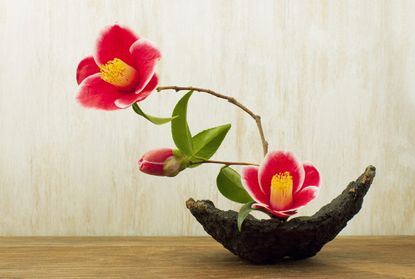What Is Ikebana – How To Do Ikebana Floral Projects


Ikebana is an ancient Japanese art of flower arranging. It has its own distinct style and system that people devote years to mastering. Reading this article won’t get you that far, but it will give you a passing familiarity with it and an appreciation for the art form. Keep reading to learn more about selecting ikebana plants and how to do ikebana.
Ikebana Information
What is ikebana? While it’s usually referred to as flower arranging, ikebana is really more about plant arranging. The goal with this practice isn’t to highlight blossoms and colors like it so often is in Western flower arranging. Instead, the focus is more on form and height, with special attention paid to the relationship between heaven, earth, and mankind.
Arranging Plants for Ikebana
Ikebana arrangements require at least three distinct parts called Shin, Soe, and Hikae. These parts are defined by height. Shin, the longest, should be at least one and a half times as long as it is wide. Ideally, it will be a long branch, maybe with flowers on the end. Shin represents heaven. Soe, the middle branch, represents earth and should be about three-fourths the length of Shin. Hikae, which represents mankind, should be about three-fourths the length of Soe.
How to Do Ikebana
Ikebana can be divided into two main styles of arrangements: Moribana (“piled up”) and Nagerie (“thrown in”). Moribana uses a wide, open vase and usually requires a frog or some other kind of support to keep the plants upright. Nagerie uses a tall, narrow vase. When arranging your ikebana plants, try to aim for asymmetry, simplicity, and lines that are pleasing to the eye. You can add more elements beyond your main three (these extras are called Jushi) but try to avoid overcrowding and keep the number of elements odd.
Gardening tips, videos, info and more delivered right to your inbox!
Sign up for the Gardening Know How newsletter today and receive a free download of our most popular eBook "How to Grow Delicious Tomatoes."

The only child of a horticulturist and an English teacher, Liz Baessler was destined to become a gardening editor. She has been with Gardening Know how since 2015, and a Senior Editor since 2020. She holds a BA in English from Brandeis University and an MA in English from the University of Geneva, Switzerland. After years of gardening in containers and community garden plots, she finally has a backyard of her own, which she is systematically filling with vegetables and flowers.